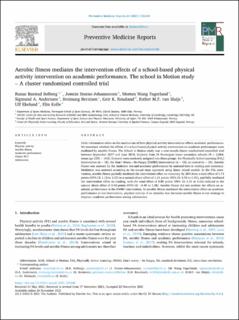| dc.contributor.author | Solberg, Runar Barstad | |
| dc.contributor.author | Steene-Johannessen, Jostein | |
| dc.contributor.author | Fagerland, Morten | |
| dc.contributor.author | Anderssen, Sigmund Alfred | |
| dc.contributor.author | Berntsen, Sveinung | |
| dc.contributor.author | Resaland, Geir Kåre | |
| dc.contributor.author | van Sluijs, Esther M.F. | |
| dc.contributor.author | Ekelund, Ulf | |
| dc.contributor.author | Kolle, Elin | |
| dc.date.accessioned | 2022-02-09T11:38:51Z | |
| dc.date.available | 2022-02-09T11:38:51Z | |
| dc.date.created | 2022-01-11T12:27:55Z | |
| dc.date.issued | 2021 | |
| dc.identifier.citation | Solberg, R. B., Steene-Johannessen, J., Wang Fagerland, M., Anderssen, S. A., Berntsen, S., Resaland, G. K., . . . Kolle, E. (2021). Aerobic fitness mediates the intervention effects of a school-based physical activity intervention on academic performance. The school in Motion study – A cluster randomized controlled trial. Preventive Medicine Reports, 24: 101648. | en_US |
| dc.identifier.issn | 2211-3355 | |
| dc.identifier.uri | https://hdl.handle.net/11250/2977969 | |
| dc.description.abstract | Little information exists on the mechanism of how physical activity interventions effects academic performance. We examined whether the effects of a school-based physical activity intervention on academic performance were mediated by aerobic fitness. The School in Motion study was a nine-month cluster randomized controlled trial between September 2017 and June 2018. Students from 30 Norwegian lower secondary schools (N = 2,084, mean age [SD] = 14 [0.3] years) were randomly assigned into three groups: the Physically Active Learning (PAL) intervention (n = 10), the Don’t Worry—Be Happy (DWBH) intervention (n = 10), or control (n = 10). Aerobic fitness was assessed by the Andersen test and academic performance by national tests in reading and numeracy. Mediation was assessed according to the causal steps approach using linear mixed models. In the PAL intervention, aerobic fitness partially mediated the intervention effect on numeracy by 28% from a total effect of 1.73 points (95% CI: 1.13 to 2.33) to a natural direct effect of 1.24 points (95% CI: 0.58 to 1.91), and fully mediated the intervention effect on reading, with the total effect of 0.89 points (95% CI: 0.15 to 1.62) reduced to the natural direct effect of 0.40 points (95% CI: −0.48 to 1.28). Aerobic fitness did not mediate the effects on academic performance in the DWBH intervention. As aerobic fitness mediated the intervention effect on academic performance in one intervention, physical activity of an intensity that increases aerobic fitness is one strategy to improve academic performance among adolescents. | en_US |
| dc.language.iso | eng | en_US |
| dc.publisher | Elsevier | en_US |
| dc.rights | Navngivelse 4.0 Internasjonal | * |
| dc.rights.uri | http://creativecommons.org/licenses/by/4.0/deed.no | * |
| dc.title | Aerobic fitness mediates the intervention effects of a school-based physical activity intervention on academic performance. The school in Motion study – A cluster randomized controlled trial | en_US |
| dc.type | Peer reviewed | en_US |
| dc.type | Journal article | en_US |
| dc.description.version | publishedVersion | en_US |
| dc.rights.holder | © 2021 The Authors. | en_US |
| dc.source.volume | 24 | en_US |
| dc.source.journal | Preventive Medicine Reports | en_US |
| dc.identifier.doi | 10.1016/j.pmedr.2021.101648 | |
| dc.identifier.cristin | 1978258 | |
| dc.source.articlenumber | 101648 | en_US |
| cristin.ispublished | true | |
| cristin.fulltext | original | |
| cristin.qualitycode | 1 | |

